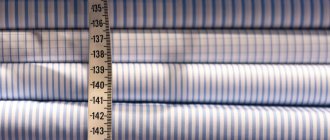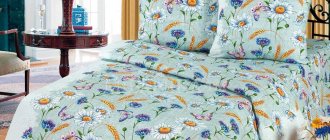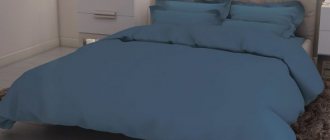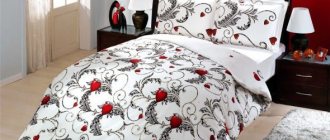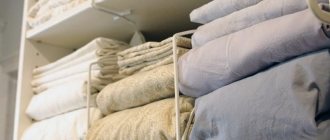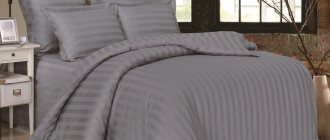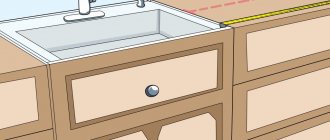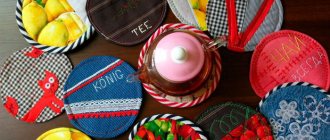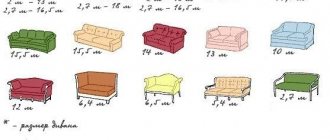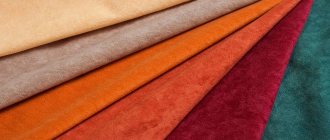How to calculate fabric for bed linen. How to sew one set of bed linen yourself
Over many years of history, bed linen has turned from a luxury item into a necessity. The modern market is full of offers, and sometimes it is very difficult to make a choice, especially when it comes to such a household item as bed linen.
Real and complete rest can only be obtained on the bed of your cozy bedroom. But the quality of the bed linen on which you sleep will also be important. Some people selectively look for ready-made bedding sets in stores, while others sew them themselves. Whether this is beneficial or not is a moot point. When sewing with your own hands, you can choose exactly the color and type of fabric that you like, and you won’t even find this in stores! And how nice it is, lying on the bed, to realize the fact that you are resting on a set that you sewed with love and with your own hands.
In this article we will tell you what is needed to sew one set of bed linen with your own hands, what tools and finally, the main question that we are often asked: “ How many meters of fabric are needed to sew different sets of bed linen
?»
Standards for a double bedding set
The approved standards for a double bedding set are listed below.
"Euro-Standard"
The same in all European countries. The exception is Italy, where you can find a duvet cover measuring 200*250 cm, as well as a sheet measuring 250*290 cm.
In other Western countries, the size of the set is more modest - a duvet cover 200*220 cm and a sheet from 220*240 cm to 240*260 cm. The number of 70*70 pillowcases in all countries is from two to four pieces.
Double bedding set
This set is made for beds with a width of 160 cm.
Important! German and Austrian sets are quite often sold without a sheet.
Double set “Euro-Standard”
"Euro-maxi"
Specialized for beds from 180 centimeters wide. In all countries, the size of the duvet cover is the same - 220*240 cm. Sheets may differ from place to place. Turkish bedding sets contain sheets from 270*310 to 290*310, while in Russia they produce 220*240 cm.
It is the largest type of bed linen. Number of pillowcases 70*70 from two to four.
Double “Euro-maxi” set
"Family"
Unlike the others, this bedding set comes with 2 one-and-a-half duvet covers. Their size varies depending on the country of origin from 150*205 to 160*220 cm. The most common is 150*210 cm.
The average size of the sheet is 230*250 cm. It comes with a standard number of pillowcases 70*70.
This type of double-bed set is suitable when sleepers like to wrap themselves tightly in a blanket.
"Family set" of bed linen
"Nursery"
Also known as "For Newborns". It has quite large sheet sizes from 100*120 to 120*170 centimeters, although it was created for a crib measuring 60*120. This was done so that the free edges of the linen would go further under the mattress. This reduces the likelihood of your child tearing off the sheet.
You may be interested in everything about furniture chenille: the properties of such fabric
The duvet cover usually has a size of 115*147 centimeters, and according to the standard there is one pillowcase 70*70.
"Nursery" set
Teenage and children's
A set of bedding for children and teenagers often corresponds to one-and-a-half size bedding, which is considered adult size. The two main differences between children's and adult underwear are the colors and the number of pillowcases in the set. Very rarely, children's sets have two pillowcases.
Teen set
Tips for choosing bed linen
It should be remembered that the main criterion when choosing a sleep kit is not its cost. When purchasing bedding sets, you want them to be of high quality, pleasant to the touch, and to last a long time. Therefore, before purchasing the set you like, you need to familiarize yourself with the following tips:
- Read the contents of the label carefully. It lists the manufacturer, parameters of the sleep sets, fabric composition, washing and ironing rules. It is not necessary to give preference to expensive imported goods. Believe me, a high-quality product is also produced by domestic manufacturers.
- Ask the seller to remove the set from the packaging and inspect the fabric. Rare weaving indicates the possibility of its deformation during washing and a decrease in parameters.
- Note the lack of seams on the duvet cover and sheet. Their presence will make your night unbearable.
- You can check for the presence of fabric odor. The presence of a strong and unpleasant “aroma” indicates that a low-quality dye was used in the production of the fabric and that during the first wash it will fade and lose its attractiveness.
- Be sure to examine all seams. They must be smooth, high quality, continuous, processed. Otherwise, after the first wash you will get a holey complex with fringe on the sections.
How much fabric is needed to sew a 1.5 bedroom KPB
One of the popular sizes of a one-and-a-half-bed set is 160*220 cm with four pillowcases 70*70. When sewing this set, it is easiest to prepare fabric measuring 165*825 centimeters. In this case, you will need a piece of 165*450 for a duvet cover, and 165*225 for a sheet. To make four pillowcases, a sheet of 150*150 centimeters is enough.
Important! When calculating the amount of fabric for sets of other sizes, it is necessary to leave 5 cm of fabric for the hemming seam. For example, for a sheet measuring 150*210, you need to prepare a sheet of 155*215 cm.
Standards for bed linen sizes
Until now, domestic manufacturers use approved bedding standards. They are prescribed in GOST 31307-2005.
| Type of kit | Sheet dimensions (cm) | Duvet cover dimensions (cm) |
| Single set | 120 x 203 (or 120 x 214) | 215 x 143 (or 215 x 153) |
| One and a half set | 130 x 214 | 215 x 143 (or 215 x 153) |
| Double set | 145 x 214 | 215 x 163 (or 215 x 175) |
| Children's set | 100 x 117 | 125 x 120 |
| Newborn kit | 100 x 138 (or 100 x 159) | 147 x 112 (or 147 x 125) |
| Teenage set | 100 x 180 | 122 x 178 |
What is a closed seam?
Covering seam is a type of connecting seam with closed sections of fabric. It is performed as connecting and connecting-finishing. As a result, only one of them is visible from the outside.
The main advantage of the seam is that there is no need to overcast fabric sections.
Important! When making a seam, allowances should be from 1.5 cm, and it should also be even over a couple of meters of the future product.
The parts must be folded with their front sides facing each other so that the bottom part protrudes by 7-9 mm. This protrusion is ironed onto the upper part. Afterwards, you need to stitch the folded piece at a distance of 2 mm from the edge, open the workpiece and iron the resulting seam on all sides. After this, you need to sew a stitch with a bartack, departing from the fold with an allowance of 2 mm. At the end, you need to iron the finished seam.
Covering seam
Several recommendations for choosing material
Bed fabric with a cherry blossom pattern
Sewing a sleeping set with your own hands gives you the opportunity to choose any fabric you want (even the cheapest - as long as you like it). However, it is important to remember that these pillowcases and sheets are for the purpose of sleeping on them; imagine what a dubious pleasure it is to “sleep on kitchen towels.”
Basic requirements for fabric.
- Softness, pleasantness, comfort - it simply needs to be suitable for sleep, as well as accompany its normal course.
- Natural - synthetic - the worst thing you can choose for sewing bed linen. Give preference to breathable, natural materials (silk, calico, cotton) that will retain heat in winter and provide normal ventilation in summer.
Natural fabric for a bedding set is the key to a sound, healthy sleep. They will not harm children's health; easy to handle; affordable.
Choosing bedding material: what is more pleasant to sleep on?
When choosing bedding, special attention should be paid to the fabric. Using underwear sets made of 100% synthetic material often leads to unpleasant sensations on the skin. Therefore, it is necessary to buy bed linen made from natural fibers or with a small percentage of synthetic fibers to ensure greater wear resistance.
Cotton, bamboo, linen
If the fabric density is required, you should choose cotton, linen or bamboo underwear sets. All these fabrics are hypoallergenic, wear-resistant, do not accumulate static electricity and are highly breathable. Cotton fabric is easy to care for and is relatively inexpensive. Linen fabric conducts heat well and does not form pills.
You might be interested in How to sew a pillow yourself using padding polyester
Silk
Bamboo bedding is softer than cotton and has antibacterial properties, which helps prevent the growth of pathogens. These fabrics have a couple of common disadvantages:
- they shrink when washed;
- often wrinkled.
Satin, silk
For lovers of smooth and shiny materials, satin and silk are suitable. Both of these fabrics are hypoallergenic, hygroscopic, wear-resistant and absorb moisture well. Also, due to their smoothness, these fabrics do not stretch the skin. Pillowcases made from these materials promote a healthy complexion. Satin fabric has a smooth and rough side, which allows the sheets not to slide off the mattresses.
Silk fabric contains sericin, which prevents the growth of fungi and dust mites in linen. Also, its threads contain fibrin, which rejuvenates the skin, improves blood circulation and improves blood circulation. The only downside to these materials is their high cost.
Percale
If you have bedding with feather and down filling, you should choose percale. This material is made from untwisted cotton threads, which are treated with a special adhesive, size, and natural ingredients. Thanks to this treatment, percale has increased strength, density, is almost not subject to deformation and does not roll down.
Percale
It is due to the density of the threads that percale does not allow bedding fillings to be knocked out. This material has its disadvantages:
- an allergic reaction to the composition of the dressing is possible;
- initially the fabric may crunch, but over time it will become soft;
- low hygroscopicity compared to cotton;
- high price.
Polycotton, flannel and chintz
For people with limited funds, it is worth taking a closer look at bedding materials such as polycotton, flannel and chintz.
Polycotton is highly durable and hardly shrinks.
Polycotton
Big disadvantages of this fabric:
- exceeds the polyester content by more than 35%, and therefore the material can generate static electricity,
- air permeability is reduced,
- “pellets” appear.
Chintz
Chintz is much less durable, but it has good hygroscopicity and air permeability. Also, calico fabric is absolutely safe and hypoallergenic. Among the disadvantages of this material are its fragility, shrinkage and rapid collapse.
Flannel fabric is very soft to the touch, but at the same time durable, retains heat well and absorbs moisture. With the exception of wool, all flannel is machine washable. Among the disadvantages of this fabric, it is worth highlighting that the hairiness of the fabric decreases with use, flannel takes a long time to dry and shrink.
You might be interested in Using matting for upholstering sofas: comparing fabric with velor
Flannel fabric
Options for choosing bed linen
The main and, perhaps, the only parameter of any bedding set will be the quality of the material from which it is made. This is what affects comfort during sleep, good mood and good spirits. The material must be breathable and moisture-permeable. Such qualities are inherent mainly in natural fibers: cotton and linen.
Currently, silk bed linen is very popular. Only wealthy people can afford it. For every day, such sets are a great luxury. They are considered exclusive.
Layout and cutting for sewing bed linen with your own hands
Having decided to start sewing bed linen, the first thing you should do is take accurate measurements that will help you correctly calculate the fabric consumption. It is also worth considering the extent to which the material can shrink and its features. For example, when calculating fabric for bed linen with a width of 220 cm, it is necessary to prepare a fabric with a width of 225 cm.
Before you start laying out and cutting, you need to wash the fabric well and then iron it. Thanks to this, the fabric will shrink, which will help you calculate the fabric correctly. To use the material wisely, you need to cut the canvas correctly. When laying out the fabric, you need to take into account the presence of raw edges of the fabric and add approximately 3 cm seam allowances on each side. When applying the pattern of the future bed to the material, it is better to use a dried bar of soap or special chalk.
Important! When cutting, it is necessary to follow the grain thread so that the fabric does not deform or lose its shape. A fractional thread can be called all the threads running along the edge of the material.
Cutting fabrics for bed linen
Calculation of fabric for children's bedding
Sewing children's bedding with your own hands is easier than sewing adult bedding. If the child is older, you can use the sizes for a one-and-a-half set, but for underwear for the little ones you need less fabric.
| Children's set 0.6x1.2 | Canvas size | |||
| 1.5 m | 2.2 m | 2.4 m | 2.8 m | |
| duvet cover | 2.2-2.3 m | 1.5 m | 1.5 m | 1.5 m |
| sheet | 1.2 m | 1.2 m | 1.2 m | 1.2 m |
| pillowcase 30x30/30x40 | remainder | remainder | remainder | remainder |
It’s difficult to say with absolute certainty how much fabric is needed for a 1.5-bed and 2-bed set, as well as euros. The most common sizes are described above. In addition, the calculation took into account plain fabrics or with small patterns, but there are fabrics with such a print that you need to calculate the fabric very carefully. Because it is very important to properly maintain the integrity of the drawing.
Sew a pillow
For pillows you need a piece of 210x150 divided in half (i.e. 2 times 105x75 cm).
The cutting pattern for bed linen (width 220) for 50x70 pillows is as follows. Width 70 cm + 70 cm + 5 cm (for allowance) + 20 cm (for allowance), length 50 cm + 50 cm + 5 cm for allowance.
We retreat 2 cm on the long side, hem it with a decorative stitch, then retreat 70 cm, bend it, and sew it on the sides from the wrong side with a double seam. Then we make a 20 cm bend again and simply process the edges on all sides. The result is a pillowcase with a bend.
After the bed linen is sewn, it must be washed again in soapy water and ironed on both sides.
Sew a duvet cover
Next comes the cutting of bed linen - a diagram with a width of 220 for a duvet cover. We fold the fabric that we measured for the duvet cover (this is 240 cm x 2 + 5 cm for allowances, a total of 480 cm) exactly in half and sew the 2 sides together with a double seam. We leave one for adjusting the blanket. It is best to take the smaller side and finish the open or closed cut with a hem stitch.
To close this side, you can use locks, snaps, buttons, whatever is convenient for you. This is the European standard cutting of bed linen (pattern for width 220). A family set requires two duvet covers, usually 160x220 cm in size, respectively, in this case both the footage and the cutting will look different.
We sew a sleeping set with our own hands
Now that you have decided, it’s time to choose which of the two methods would be preferable to accomplish this. You can sew:
Manually is a very dubious, energy-consuming enterprise. This method is only suitable for super extreme people who don’t mind their time or other resources. Or those who do not have a sewing machine. In any case, do not expect professional quality, as well as durability, from such a set.
Using a sewing machine - the process will take less of your time and effort. With a sewing machine, the seams, and therefore the strength, will be much more reliable, and you can even enjoy the process.
To sew a sheet, as well as the free edges of a pillowcase and duvet cover, use a hem stitch with a closed cut
So, you have what you need, including raw materials, measurements and a good mood. Now that you have prepared your workspace, which means it’s time to get down to business.
For sewing duvet covers and pillowcases, a bed stitch is used, which is sometimes also called a backstitch
The most proven technique for sewing bedroom sets is the “Sewing stitch”.
This is what a linen seam looks like from the front side
How it's done?
- Each of the parts is folded with the wrong side out, while the bottom side is released approximately 7 mm in order to then lay it on top of the top part.
Take a piece of fabric intended for a pillowcase, make a hem seam on one side of the fabric
We sew the side edges of the pillowcase with a double seam
We sew a duvet cover with our own hands: sew the side seam
Making the second line of the double seam
By sewing in this way, you are guaranteed to ensure the durability of the future set due to a strong connection with the machine. Subsequent seams must be made in this manner. The sheet is sewn with a standard machine stitch.
We sew the zipper with a horizontal seam first to one and then to the second side of the future duvet cover slot
When you start sewing a duvet cover, the main thing is to leave a space designated for the entrance hole, where the blanket will then be inserted. Its edges can also be sewn with a regular seam.
Ready-made pillowcase, hand-sewn
DIY duvet cover with zipper
Patterns for sewing sleeping linen with your own hands
We cut the sheet to cover the entire width of the fabric, and calculate the length using the formula: length of the mattress + 20 cm
We make the length of the duvet cover to cover the entire width of the fabric, and calculate the width of the duvet cover using the formula: the width of your blanket + 6 cm (shrinkage allowance) + 1.5 cm (seam allowance) x 2
Cutting is the second, but not the most important, stage, the stage after taking measurements and establishing the required size of the canvas. Here you are required to apply maximum care, since it is very important not to cut off too much, otherwise it will no longer be possible to correct it. Next, we will give some tips to optimize the sewing process as much as possible and avoid damage to expensive brocade through your own efforts.
A piece of fabric for pillowcases 50 by 70 cm = (50 cm x 2 + 25 cm (at the hem) + 5 cm (seam allowances))
Piece for pillowcases 70 by 70 cm = (70 cm (side) x 2 + 25 cm (at the hem) + 5 cm (seam allowances))
How to calculate material for European parameters?
In modern life, euro sets are considered the most acceptable bedding option. You can purchase them, or you can sew them yourself by choosing a special material. As for sizes, there are several applicable standards for Euro kits. The most common option is 220x240 cm. Regarding pillowcases, it depends on the pillows. These can be sizes 50x70 or 70x70 centimeters. To understand what the fabric consumption will be for the required size, you need to study the table.
Taking into account shrinkage allowances
Any fabric, especially new fabric, shrinks. This is important to take into account, otherwise during use the bed linen will shrink so much that it will be too small. You should also not leave too large allowances. If the duvet cover is large, the blanket gets confused or slips. Pillowcases that do not fit on the pillow also look unsightly and can gather in folds.
Typically, linen and cotton fabrics are used for bed linen, for example, calico, satin, poplin. They, like silk, shrink up to 5%. If there is an admixture of synthetics (ranfors), then this figure is lower - up to 2-4%. The denser soft flannel used for winter sets shrinks slightly.
Synthetic fabric shrinks less. But it is irrational to use it specifically for sewing sleeping sets. It absorbs sweat poorly, does not “breathe”, and can cause overheating of the body or cause allergies. Therefore, the optimal ratio in the composition of bed linen does not exceed 20%.
To reduce the risk of shrinkage of the bedding set, you can do decating - wet-heat treatment of the fabric. The cut must first be washed or soaked in warm water not exceeding 40 degrees Celsius.
Then squeeze lightly and hang evenly on the dryer with the grain facing down. If you hang it to dry with the transverse side down, the cut may become skewed during drying. To understand which side is which, you need to pull the fabric to the sides. Where it stretches poorly is the lobar thread, where it stretches better is the transverse thread.
Next, the slightly damp fabric should be ironed from the wrong side in the direction of the grain thread using the steam function. Now you can cut. In this case, it is still recommended to leave allowances. During use, laundry may shrink further, for example, when boiling or washing at high temperatures and speeds.
You will learn how to properly cut fabric for a 2-bed bedding set by watching the following video.
What to pay attention to when calculating
High-quality bedding should be seamless, so it is very important to correctly measure all the details of the set so that you do not have to sew on additional strips and pieces. Natural materials are usually used to make bedding:
All of them, in addition to many positive qualities, have one drawback - they shrink after washing. If cotton underwear is washed at a water temperature close to the boiling point, the product will shrink slightly in size with each wash. You need to remember this when buying fabric in a store, and add about 5% of the length for shrinkage to the calculated amount.
Many housewives prefer materials consisting of a mixture of cotton and polyester to natural compositions. Such fabrics wrinkle less and hardly shrink after washing. However, if the fabric contains more than 30% synthetic fibers, then it is less breathable and does not absorb moisture well.
Before calculating the fabric needed to sew a product, you need to correctly take measurements, carefully measuring the length and width of the bedding.
- To avoid mistakes, you can measure the old set and add 6 cm to the seams.
- When calculating the fabric needed to make a duvet cover, you need to add at least 8 cm to the size of the blanket for free movement.
- To calculate the amount of material for making a sheet, you should measure not only the width, but also the height of the mattress, add these values and add another 20 cm on both sides. The sheet should not jump out from under the mattress, otherwise it will be uncomfortable to sleep on such linen.
- To sew pillowcases, the parameters of the pillow are measured. Pillowcases can be sewn in two ways: with a bend and with a zipper. In the first case, at least 30 cm is left for the bend. If, in order to save money, the bend is made smaller, then the pillow will look ugly and spoil the appearance of the entire set. For the zipper, it is enough to leave a margin of 5 cm.
After all the bedding has been measured, add up the resulting values. Their sum indicates how many meters of linen need to be purchased to make linen.
